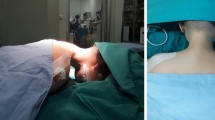Summary.
Summary.
Background:
The authors report the clinical application of a new microsurgical technique. The cervical anterior foraminotomy (uncoforaminotomy), which is used for the surgical treatment of unilateral cervical radiculopathy secondary to posterolateral disc herniations or spondylotic foraminal stenoses.
Method:
Between June 2000 and May 2001, 34 patients (16 men and 18 women with a mean age of 43.8 years, range 29 to 80 years) underwent anterior cervical foraminotomy (uncoforaminotomy) for the treatment of cervical radiculopathy at one or two adjacent levels in the Neurosurgical Department of the University of Vienna. This surgical technique was devised to accomplish direct anterior decompression of the affected nerve root by removing an offending posterolateral sponylotic spur or disc fragment. The nerve root is decompressed from its origin in the spinal cord to the point were it passes behind the vertebral artery laterally. The intervertebral disc of the affected level is maintained in its form and function. Thus, the functioning motion segment is preserved and fusion related sequelae, including graft related complications, graft site complications and the adjacent level disease, are avoided.
Prior to its clinical application, anatomical features of the anterior cervical spine were reviewed, and an anatomical morphometric analysis and work-up of the technique was performed in 4 cervical specimens.
Findings:
The follow-up period varied from two to 17 months with a mean of 8.2 months. The large majority (97%) of patients were pleased with the results of their operation. The relief of neck pain and redicular pain in the affected dermatome was immediate in all patients. Motor-weakness and sensory deficit improved dramatically immediately postoperatively, and improved to normalisation in the majority of patients within 3 to 6 months. Two of the patients sustained an incomplete transient recurrent laryngeal nerve palsy, which fully resolved within two to 4 weeks. One of the patients had a repeat herniation on the second postoperative day, but recovered completely after re-operation and continued to do well at the 6-month follow-up. No permanent surgery related morbidity or associated complications were encountered.
Interpretation:
The results indicate that this new microsurgical technique is an attractive treatment option for adequate anterior decompression of the cervical nerve root via a minimized approach. It was associated with excellent clinical outcome and a less painful postoperative course, allowing patients an almost immediate return to unrestricted full activity.
Similar content being viewed by others
Author information
Authors and Affiliations
Additional information
Published online July 18, 2002
Rights and permissions
About this article
Cite this article
Saringer, W., Nöbauer, I., Reddy, M. et al. Microsurgical Anterior Cervical Foraminotomy (Uncoforaminotomy) for Unilateral Radiculopathy: Clinical Results of a new Technique. Acta Neurochir (Wien) 144, 685–694 (2002). https://doi.org/10.1007/s00701-002-0953-2
Issue Date:
DOI: https://doi.org/10.1007/s00701-002-0953-2




